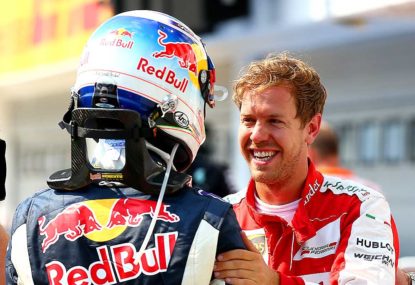Angry Carlos Sainz almost demands Oscar Piastri give back on-track spot after fierce battle
The Spanish driver claimed he was forced off the track while trying to overtake into fourth spot and wanted the McLaren driver to give…

Sebastian Vettel has never been one to seek the limelight. He has sensible haircuts, dresses appropriately for the prevailing weather conditions, and hasn’t even once released a rap album.
But it doesn’t take a bottle of peroxide to be interesting – anyone who’s spent even a fleeting moment in the presence of the four-time champion, seen him on Top Gear, or watched as he riled up the feuding Nico Rosberg and Lewis Hamilton throughout 2015 understands that Vettel has real character.
Combine these two distinct personality types and you have a recipe for intrigue – when Vettel talks, Formula One listens.
Because he isn’t in the business of making sure you know what he thinks (see: Jacques Villeneuve), when he does voice an opinion, it’s almost always reasoned and considered.
“I believe that primarily it should be about sport and accordingly which driver is fastest,” he mused this week on his website.
“The car currently plays a significant role, as it did in the past. However, we should not lose ourselves in complicated rules.
“The current regulations are too detail-orientated. I believe we should not lose sight of the motorsport’s roots and that in future we are able to once again identify with the cars.”
Vettel, as a self-styled student of Formula One, knows the debate over the future of Formula One is reaching a crescendo. His comments are well timed – next Saturday, February 28, the rules for 2017, for so long billed as the regulations that will frame the next generation of Formula One, must be confirmed. It’s a critical juncture.
Let’s work backwards. Are the current regulations too detail oriented? It’s certainly easy to construct an argument in the affirmative.
Whether it is the insane number of grid place penalties accrued by McLaren last season, the seldom explained usage and detection zones for the DRS, or the fact that no child will ever be able to draw a modern Formula One front wing in the back of their maths book, there are aspects of Formula One supposedly under the ‘competition and performance’ header that are difficult to understand.
Consider that next season, in addition to a new ‘ultra-soft’ tyre, teams will be able to mix and match their weekend’s tyre allocation using three different compounds. On paper it sounds like an interesting way to spice up the racing, but even Sky Sports F1’s TV heart-throb Ted Kravitz has difficulty explaining exactly how these rules will work.
Formula One has arrived in this place because it is too symptom focussed. Bandaid has been placed on top of bandaid until the original problem is hidden from view under a festering stack of medical plastic.
Here it is easy to understand Vettel’s concern that the skill of the driver is being masked by the technicalities of the sport.
But on the other hand oversimplifying Formula One would be equally dangerous. Introducing standard specification power units or customer cars risk dumbing down the sport into a WWE version of itself.
Since the turbocharged V6 hybrid power units have been introduced we have relentlessly been told by barrow-pushers how precipitously close GP2 lap times are to those set by Formula One cars – yet no-one switched over to GP2 at Formula One’s expense, despite the racing at the junior levels being insane.
GP2 is, by necessity, a watered-down version of Formula One in which all teams operate identical machinery. The driver dictates the majority of the performance while the team has an operational impact on the weekend’s results. But we do not consider GP2 to be somehow more gladiatorial than Formula One, because without an avenue for the teams to pursue performance GP2 remains only half a show.
Somewhere in between the two extremes sits the appropriate balance. Somewhere with development avenues targeted at areas that can accentuate a driver’s strengths rather than curtail them, and somewhere a bona fide team can innovate to control its own destiny.
We already know that restrictions on what and how much of the power unit can be developed will be lifted over the next 12 months, enabling the most advanced – and difficult to master – part of the car to come into its own.
Next the 2017 regulations must simplify aero regulations to a point whereby they can enhance performance without affecting a driver’s ability to race at close quarters – which in turn will allow Pirelli’s tyres to do their job more effectively without complex rules clouding the whole show.
Formula One is precariously balanced between competing performance factors. While the drivers are the centre of attention, so too must the design of the cars play a part.
Because without the prestige of the world’s best car manufacturers and racing teams genuinely battling each other in their area of expertise, Formula One’s claim to the top of the motorsport heap loses its credibility.
But Sebastian Vettel knows all this. The real question is whether Formula One’s power brokers have realised in time for next weekend.
Do you think Vettel is right when he says Formula One is too detail oriented? How would you change the Formula One regulations?
Follow @MichaelLamonato on Twitter.